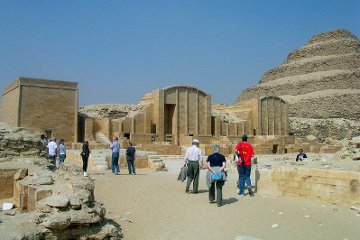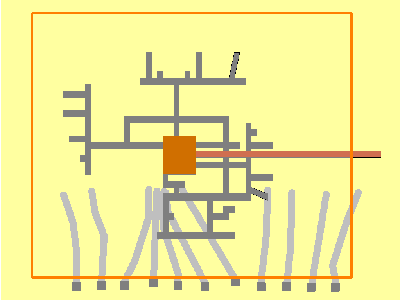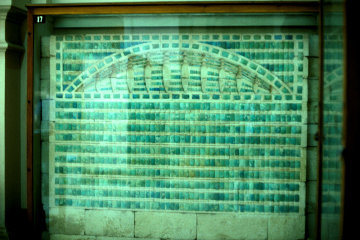Propping up the Step Pyramid
Tourists who visit the Step Pyramid of Djoser at Saqqara are rightly impressed by the visible remains, for this is the largest funerary complex in the land of Egypt.
Although the Step Pyramid is visible from a considerable distance, the first thing that strikes the visitor's eye is the massive enclosure wall, 30' high and 2,400' long. The wall is elaborately carved - not built - with a series of vertical panels in what is known as "palace facade" style and which is believed to represent the royal palace made of planks of timber. There are fourteen gateways into the enclosure, but thirteen of them are dummies or false doorways - solid stone carved to look like a gateway.

|
| The dummy buildings in the courtyard of the Step Pyramid. |
The Egyptians were fond of false doorways and many tombs have them carved into their walls. They were intended for the use of the ka or spirit of the dead person who could easily pass through the stone. Why a spirit would wish to confine itself to passing through the stone of the false door rather than any other more convenient entry point is not clear - possibly the Egyptians just thought it would be undignified to emerge from a blank wall!
The dummy gateways, however, are on a par with the rest of the structures inside the courtyard around the Step Pyramid, for all the elaborate buildings are simply facades constructed around a solid core of rubble. They were erected for the use of the royal ka, which didn't need rooms and corridors in order to enjoy the facilities of the buildings!
However when we turn to the pyramid itself we find that there are a large number of very real passageways and chambers beneath it. The first stage of construction was a shaft 90'deep and 22' square dug into the solid rock. A ramp led down into this from the north. At the bottom of the shaft a network of tunnels was excavated - altogether there are said to be 6km of tunnels associated with the Step Pyramid! Several sections of the tunnels have been faced with glazed tiles in the familiar "palace facade" style and we presume that the original intention was to cover all the tunnels in this way but presumably Djoser died before the project could be completed. Most of these tunnels were intended as storage space for the royal funerary goods and 40,000 stone vessels have been found in them.

|
| The underground passages of the Step Pyramid. At the bottom are the eleven burial shafts; the approach ramp is on the right, the burial shaft in the centre. |
An untidy row of eleven shafts was dug along the east side of the original mastaba. At the bottom these shafts became horizontal passages extending under the structure. It is believed that they were intended for the burial of members of the royal court, possibly especially favoured members of Djoser's harem. However they were never used for this purpose; as the original mastaba was enlarged to become the Step Pyramid, it covered the shafts, making access to them impossible.
On top of this network of tunnels and the burial shaft itself, Imhotep erected first a single mastaba and then a pyramid of four steps and finally a pyramid of six steps, 203' tall. The pyramid is not square, but measures 410'x358' at the base. Exactly how the pyramid was built over a hole 22' square is not clear; obviously there were no girders spanning the gap and I presume that the shaft has a corbelled roof where each layer of stones is built out a little further over the hole until they meet in the middle.
It is this hole which is worrying the Egyptian Department of Antiquities. Owing to the poor quality of the rock through which the tunnels and approach ramp are cut, the subterranean part of the pyramid has never been open to the public - it is just too dangerous! Many is the time I have looked longingly at the entrance to the ramp, but quite apart from the probability of being caught, I have a lively sense of self-preservation and the decaying timbers propping up the sides of the ramp have not engendered confidence. You might say that I am allergic to being buried alive!

|
| A section of tiles from the tunnels of the Step Pyramid. Note the arc of heb sed pillars at the top. |
Several times over the years we have heard reports that part of the roof of the tunnels has fallen in, but obviously it has been impossible for us to confirm these reports and Egyptian officials have been tight-lipped about the matter when we approach them. Now, however, the authorities have admitted that the 1992 earthquake caused significant damage to the subterranean passageways, causing part of the ceiling to collapse.
Cintec, a restoration firm based in Newport, south Wales, has been involved in several prestigous restoration projects, including the repair of Windsor Castle following the fire in 1992 and repairs to an old bridge in New Delhi in time for the Commonwealth Games last year. It has been awarded a contract worth £1.8 million to rescue Djoser's famous monument.
According to the details of the contract announced in January 2011, Cintec plans to put water-filled bags into the burial chamber to support the fallen ceiling. It is not clear whether these are intended as pemanent features or just temporary measures - I suspect the latter - as there is also talk of stainless steel reinforcing rods being installed. Peter James, Cintec's managing director, stated, "The Step Pyramid project is of particular importance to us as the entire structure could be destroyed at any point due to the damage to the ceiling and roof caused by the earthquake."
Unfortunately it does not appear that any of this work will enable the underground passageways to be opened to visitors. We will continue to have to imagine that 19,500' of tunnels beneath our feet, the dust slowly filtering down from the walls and ceiling, the beautiful faiance tiles cracking and falling, and the body of the pharaoh for whom all this was built scattered in fragments across the desert after his tomb was robbed in antiquity.
planks of timber Some claim that in fact the carving represents bundles of reeds. This is unlikely for the simple reason that reeds were rounded, as can be seen in the pillars of the entrance hall. In addition there are rectangular recesses cut into the "palace facade" that are believed to represent roof beams or mortice-and-tenon joints, neither of which would appear in a reed building. Return
© Kendall K. Down 2011





